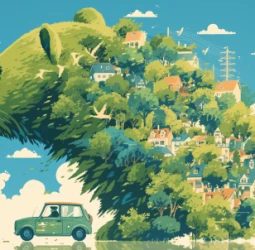Deforestation is a global issue that has far-reaching consequences for the environment. One of the most affected regions by this phenomenon is the Cerrado, a vast tropical savannah in Brazil. The Cerrado covers an area of approximately 2 million square kilometers, making up 21% of the country's land area. It is known for its incredible biodiversity, being home to thousands of plant and animal species. Unfortunately, this unique ecosystem is facing a grave threat due to deforestation.
The Cerrado has been described as the "forgotten forest" because it often gets overshadowed by the more well-known Amazon rainforest. However, it is just as important, if not more, in terms of its role in maintaining the Earth's ecological balance. The Cerrado is responsible for regulating the water cycle in Brazil, storing carbon, and providing livelihoods for millions of people. It is also home to rare and endemic species such as the jaguar, giant anteater, and maned wolf.
The primary cause of deforestation in the Cerrado is agriculture. The savannah's fertile soils make it ideal for growing crops such as soy, maize, and cotton. As a result, large areas of the Cerrado have been cleared for agricultural expansion, mostly for livestock and crop production. According to a recent study, between 2000 and 2014, the Cerrado lost an average of 237,000 square kilometers of its vegetation cover, equivalent to a football field every two minutes. This alarming rate of deforestation is not only a threat to the Cerrado's unique ecosystem but also has significant global implications.
One of the major consequences of deforestation in the Cerrado is the loss of biodiversity. The savannah is home to over 10,000 plant species, of which approximately half are endemic. With the destruction of their natural habitat, many of these species are facing extinction. The decline in biodiversity can also have a ripple effect on other species, leading to a disruption in the entire ecosystem.
Moreover, deforestation in the Cerrado has a significant impact on climate change. Trees are vital in the process of carbon sequestration, which helps to mitigate the effects of greenhouse gas emissions. With the loss of vegetation cover, there is a reduction in the amount of carbon stored in the Cerrado, contributing to the increasing levels of carbon dioxide in the atmosphere. This, in turn, aggravates the effects of climate change, leading to more severe and frequent natural disasters.
Deforestation also has consequences for the local communities that depend on the Cerrado for their livelihoods. Indigenous communities, traditional populations, and small-scale farmers rely on the savannah for their food, medicine, and cultural practices. With the destruction of their environment, their way of life is at risk, and they are often forced to migrate to urban areas in search of alternative livelihoods.
To address the issue of deforestation in the Cerrado, the Brazilian government has implemented several policies and initiatives. In 2003, the Cerrado Sustainable Development Program was launched, promoting sustainable land use practices and conservation measures. In 2011, the Cerrado Manifesto was also signed, in which companies committed to sustainable sourcing of agricultural products from the Cerrado.
However, despite these efforts, deforestation in the Cerrado continues to be a pressing issue. The lack of strict enforcement of environmental laws, corruption, and political pressure from the agribusiness lobby are some of the contributing factors. It is crucial for the government to take more decisive action to protect the Cerrado and its biodiversity.
In conclusion, deforestation in the Cerrado is a severe environmental issue that requires immediate attention. The destruction of this unique ecosystem not only affects the local communities and biodiversity but also has global implications for climate change. It is the responsibility of both the government and individuals to take action and protect the Cerrado for the sake of future generations. Sustainable land use practices and stricter enforcement of environmental laws are crucial in preserving this vital ecosystem.
The Cerrado has been described as the "forgotten forest" because it often gets overshadowed by the more well-known Amazon rainforest. However, it is just as important, if not more, in terms of its role in maintaining the Earth's ecological balance. The Cerrado is responsible for regulating the water cycle in Brazil, storing carbon, and providing livelihoods for millions of people. It is also home to rare and endemic species such as the jaguar, giant anteater, and maned wolf.
The primary cause of deforestation in the Cerrado is agriculture. The savannah's fertile soils make it ideal for growing crops such as soy, maize, and cotton. As a result, large areas of the Cerrado have been cleared for agricultural expansion, mostly for livestock and crop production. According to a recent study, between 2000 and 2014, the Cerrado lost an average of 237,000 square kilometers of its vegetation cover, equivalent to a football field every two minutes. This alarming rate of deforestation is not only a threat to the Cerrado's unique ecosystem but also has significant global implications.
One of the major consequences of deforestation in the Cerrado is the loss of biodiversity. The savannah is home to over 10,000 plant species, of which approximately half are endemic. With the destruction of their natural habitat, many of these species are facing extinction. The decline in biodiversity can also have a ripple effect on other species, leading to a disruption in the entire ecosystem.
Moreover, deforestation in the Cerrado has a significant impact on climate change. Trees are vital in the process of carbon sequestration, which helps to mitigate the effects of greenhouse gas emissions. With the loss of vegetation cover, there is a reduction in the amount of carbon stored in the Cerrado, contributing to the increasing levels of carbon dioxide in the atmosphere. This, in turn, aggravates the effects of climate change, leading to more severe and frequent natural disasters.
Deforestation also has consequences for the local communities that depend on the Cerrado for their livelihoods. Indigenous communities, traditional populations, and small-scale farmers rely on the savannah for their food, medicine, and cultural practices. With the destruction of their environment, their way of life is at risk, and they are often forced to migrate to urban areas in search of alternative livelihoods.
To address the issue of deforestation in the Cerrado, the Brazilian government has implemented several policies and initiatives. In 2003, the Cerrado Sustainable Development Program was launched, promoting sustainable land use practices and conservation measures. In 2011, the Cerrado Manifesto was also signed, in which companies committed to sustainable sourcing of agricultural products from the Cerrado.
However, despite these efforts, deforestation in the Cerrado continues to be a pressing issue. The lack of strict enforcement of environmental laws, corruption, and political pressure from the agribusiness lobby are some of the contributing factors. It is crucial for the government to take more decisive action to protect the Cerrado and its biodiversity.
In conclusion, deforestation in the Cerrado is a severe environmental issue that requires immediate attention. The destruction of this unique ecosystem not only affects the local communities and biodiversity but also has global implications for climate change. It is the responsibility of both the government and individuals to take action and protect the Cerrado for the sake of future generations. Sustainable land use practices and stricter enforcement of environmental laws are crucial in preserving this vital ecosystem.



 dev1
dev1















